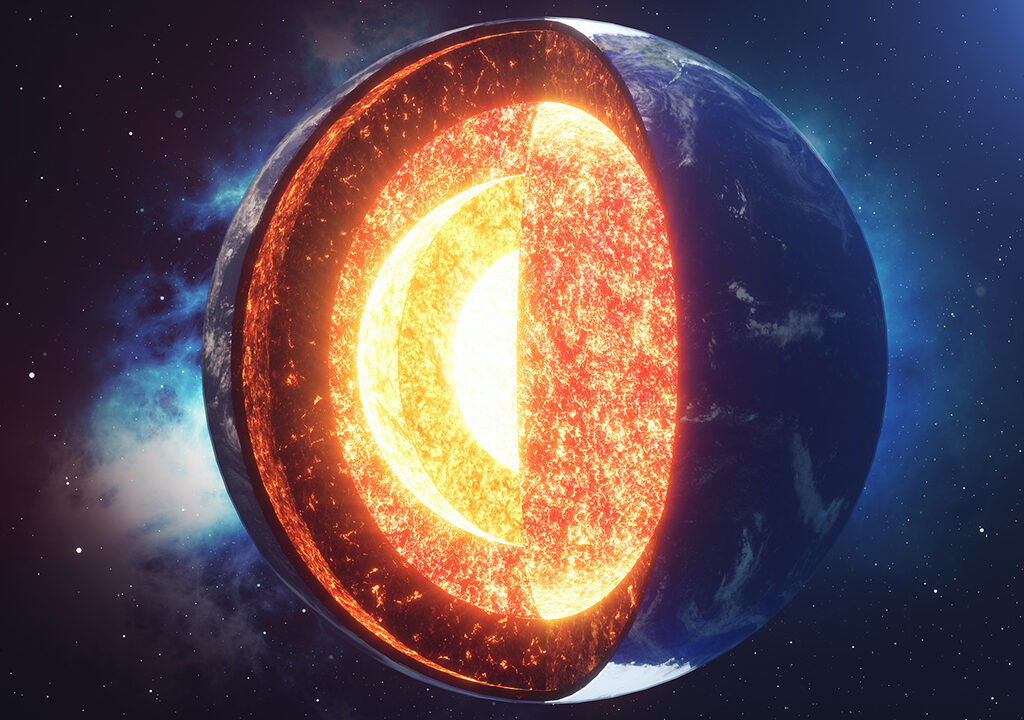
Media Contact: Carmen Ramos Chandler, carmen.chandler@csun.edu, (818) 677-2130
A team of researchers that includes chemistry students and faculty at California State University, Northridge have just completed a massive computational study of the element iron’s behavior at the Earth’s core. Their findings have caused a fundamental shift in the understanding of how iron reacts under intense pressure.
The rules that apply to iron on the surface of the Earth are reversed when iron is under the extreme conditions found at the Earth’s core, said CSUN chemistry professor Maosheng Miao.
“We found new chemical behavior or, if you want to use stronger words, new chemistry for the behavior of iron under high pressure,” said Miao, who teaches in the College of Science and Mathematics. “This has significance for understanding the composition and behavior of the Earth’s interior. The Earth is largely composed of iron, especially at its core. Our assumptions about how iron behaves are based on how it behaves at the surface of the Earth. What we have found points to a profound shift in its oxidation-reduction behavior.”
Oxidation-reduction behavior, Miao explained, is the transfer of electrons between substances in a chemical reaction. During this process, one element is oxidized, or loses electrons, while another is reduced, or gains those electrons. This process is key to identifying redox, or oxidation-reduction, reactions.
On the surface of the Earth, Miao said, iron is known as a reductant because it loses electrons in almost all reactions it involves. He pointed to the rusting of iron as an example, in which oxygen is the oxidizing agent, it accepts electrons, and iron is the reducing agent because it donates electrons.
“But deep down in the Earth, especially at the Earth’s core, that flips,” Miao said. “At the Earth’s core, instead of giving up electrons to many non-metal elements, iron might take electrons from them. Which is generally counterintuitive to what we know about how it reacts at the Earth’s surface, which is what we have based so much of our understanding of chemical reactions on, because for a long time, that’s all we knew.
“What we learned will change the rules of engagement,” he continued. “Surface iron wants more to share electrons. Deep iron wants more to grab them.”
The study, “Pressure-induced redox reversal of iron and the distribution of elements in deep Earth,” appears in The Proceedings of the National Academy of Sciences (PNAS). In addition to Miao, its CSUN authors include Xiaoli Wang, now with the School of Physics and Electronic Information at Yantai University in China and formally a visiting scholar at CSUN; Austin Ellis and Samantha Scott, Abhiyan Pandit, and Dalar Khodagholian, Department of Chemistry and Biochemistry at CSUN. The work was also conducted with collaborations of Russell J. Hemley in the Departments of Physics, Chemistry, and Earth and Environmental Sciences at the University of Illinois, Chicago;Matthew Jackson and Frank Spera, in the Department of Earth Science at the University of California, Santa Barbara;and Simon Redfern, in the Asian School of the Environment at Nanyang Technological University.
Miao said the reversal of iron’s behavior has implications for how a diverse group of elements, known as the p-block because of where they are found on the periodic table, bond under intense pressure. They include substances like nonmetals like sulfur and iodine and metalloids like silicon and arsenic and metals like aluminum and lead.
Scientists have assumed that pressure explained why some elements were “missing” at the Earth’s core — “that they were sucked into the core because iron binds them so strongly down there,” Miao said.
“That was the prevailing thought, especially for things like noble gases,” he said. “But the study suggests it’s not quite that simple.
Miao said the study added “a critical nuance” when the researchers systematically compared two things: the calculated strength of the chemical bond between iron and a p-block element under pressure, and the actual measure of depletion of that element in the silicate Earth.
What they found was an inverse correlation.
“The elements that bind most strongly to iron in the Earth’s core are actually the ones that are less depleted in the silicate Earth,” Miao said. “They are more abundant in the mantle and the crust than you’d expect if strong binding is stealing them away.”
Miao said the latest studies raise questions for scientists to explore going forward, “and that’s what makes this study so interesting, because it encourages us to explore a wider range of factors, such as the chemical behavior of elements in silicates.”




Comments are closed.